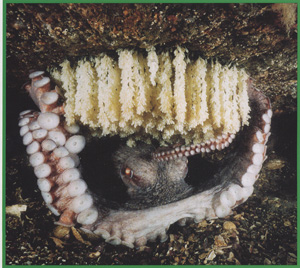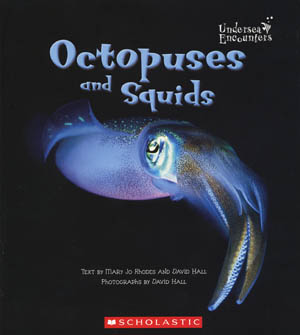No, it’s not a cage-match between syngnathids and cephalopods. Rather, the Free-Ride offspring consider the relative merits of each. It’s kind of like weighing whether you’d rather be able to fly or become invisible.

From Seahorses and Sea Dragons
* * * * *
Elder offspring: I like the sea dragons the best. Their bodies have these leafy parts, so they can hide from predators in seaweed.
Younger offspring: An octopus can camouflage, too. It can change colors to look like the ocean floor.
Elder offspring: Well, an octopus can also change its body shape.
Younger offspring: Yeah, and squish into narrow caves.

Elder offspring: With seahorses and sea dragons, the males are the ones that give birth.
Younger offspring: How does that work?
Elder offspring: The female puts her eggs in a pouch the male has — the brood pouch — and then he fertilizes them with the sperm. And then the eggs develop in the pouch.
Younger offspring: And the pouch gets fat, and then the baby seahorses come out.
Elder offspring: With male sea dragons, there’s not a pouch. There’s a brood patch under their tails. So the females stick their eggs onto the patch, and they get fertilized and grow there.
Younger offspring: Cool.

Elder offspring: The octopus eggs develop outside their bodies.
Younger offspring: In their caves.
Elder offspring: But some of the ones without caves [like the blue-ringed octopus] have to carry their fertilized eggs around with their arms.
Younger offspring: They guard them while they’re developing.
Elder offspring: And squirt water on them to give them oxygen. But after the eggs hatch, the mother octopus dies.
Dr. Free-Ride: Yeah, it’s one of those “Charlotte’s Web” kind of life cycles. The book says the octopuses prefer to be alone rather than with other octopuses.
Elder offspring: So the female gets the sperm from a male she’s just met, and then she’s alone again. But the seahorses are social and get to know each other first before the female gives her eggs to the male.
Younger offspring: Squids like to play with other squids.
Elder offspring: I’d like to be a seahorse or a sea dragon or a squid, but not an octopus, because I like to hang out and be social.
Younger offspring: Sometimes you’re an octopus when you tell me to go away because you want to be alone.
Elder offspring: But sometimes we’re squids because we hang out and we’re fast. And we siphon each other for fun!
* * * * *
The Sprogs Recommend:

Octopuses and Squids by Mary Jo Rhodes and David Hall. Photographs by David Hall.

Seahorses and Sea Dragons by Mary Jo Rhodes and David Hall. Photographs by David Hall.
We love books with chapters, lots of photographs, and glossaries. What can I say?

What a great site. I am always looking for interesting and educational sites that my grand kids can learn from and still have fun. With all the great pics you have it will be easy for them here. 🙂
Thank you.
Pingback: Ciencia para niños « Comunidad Salud